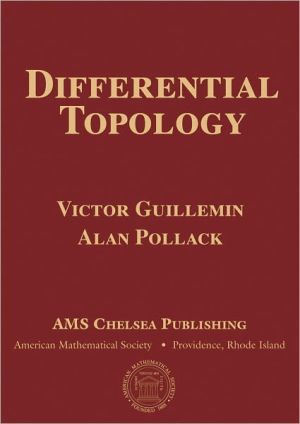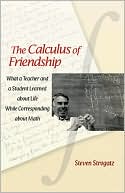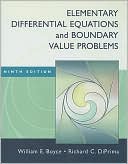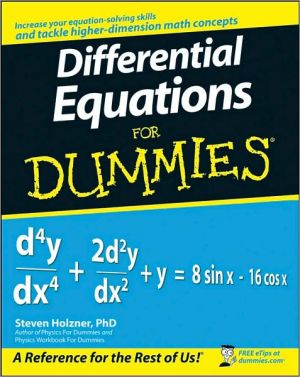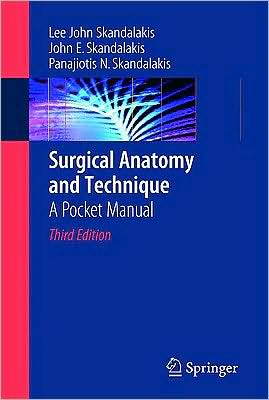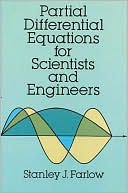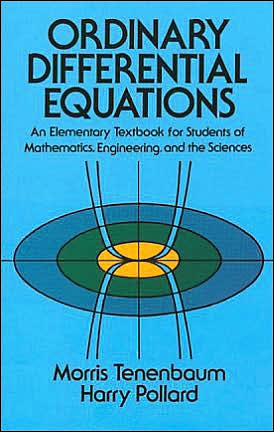Differential Equations: An Introduction to Modern Methods and Applications
Differential Equations: An Introduction to Modern Methods and Applications is a textbook designed for a first course in differential equations commonly taken by undergraduates majoring in engineering or science. It emphasizes a systems approach to the subject and integrates the use of modern computing technology in the context of contemporary applications from engineering and science. Section exercises throughout the text are designed to give students hands-on experience in modeling,...
Search in google:
Differential Equations: An Introduction to Modern Methods and Applications is a textbook designed for a first course in differential equations commonly taken by undergraduates majoring in engineering or science. It emphasizes a systems approach to the subject and integrates the use of modern computing technology in the context of contemporary applications from engineering and science. Section exercises throughout the text are designed to give students hands-on experience in modeling, analysis, and computer experimentation. Optional projects at the end of each chapter provide additional opportunitites for students to explore the role played by differential equations in scientific and engineering problems of a more serious nature.
1. Introduction. 1.1 Some Basic Mathematical Models; Direction Fields. 1.2 Solutions of Some Differential Equations. 1.3 Numerical Approximations: Euler's Method. 1.4 Classification of Differential Equations. 2. First Order Differential Equations. 2.1 Linear Equations; Method of Integrating Factors. 2.2 Separable Equations. 2.3 Modeling with First Order Equations. 2.4 Differences Between Linear and Nonlinear Equations. 2.5 Autonomous Equations and Population Dynamics. 2.6 Exact Equations and Integrating Factors. 2.7 Accuracy of Numerical Methods. 2.8 Improved Euler and RungeKutta Methods. Summary. Projects. 2.P.1 Harvesting a Renewable Resource. 2.P.2 Designing a Drip Dispenser for a Hydrology Experiment. 2.P.3 A Mathematical Model of a Groundwater Contaminant Source. 2.P.4 Monte Carlo Option Pricing: Pricing Financial Options by Flipping a Coin. 3. Systems of Two First Order Equations. 3.1 Systems of Two Linear Algebraic Equations. 3.2 Systems of Two First Order Linear Differential Equations. 3.3 Homogeneous Linear Systems with Constant Coefficients. 3.4 Complex Eigenvalues. 3.5 Repeated Eigenvalues. 3.6 A Brief Introduction to Nonlinear Systems. 3.7 Numerical Methods for Systems of First Order Equations. Summary. Projects. 3.P.1 EigenvaluePlacement Design of a Satellite Attitude Control System. 3.P.2 Estimating Rate Constants for an Open TwoCompartment Model. 3.P.3 The Ray Theory of Wave Propagation. 3.P.4 A BloodBrain Pharmacokinetic Model. 4. Second Order Linear Equations. 4.1 Definitions and Examples. 4.2 Theory of Second Order Linear Homogeneous Equations. 4.3 Linear Homogeneous Equations with Constant Coefficients. 4.4 Characteristic Equations with Complex Roots. 4.5 Mechanical and Electrical Vibrations. 4.6 Nonhomogeneous Equations; Method of Undetermined Coefficients. 4.7 Forced Vibrations, Frequency Response, and Resonance. 4.8 Variation of Parameters. Summary. Projects. 4.P.1 A Vibration Insulation Problem. 4.P.2 Linearization of a Nonlinear Mechanical System. 4.P.3 A SpringMass Event Problem. 4.P.4 Uniformly Distributing Points on a Sphere. 4.P.5 EulerLagrange Equations. 5. The Laplace Transform. 5.1 Definition of the Laplace Transform. 5.2 Properties of the Laplace Transform. 5.3 The Inverse Laplace Transform. 5.4 Solving Differential Equations with Laplace Transforms. 5.5 Discontinuous Functions and Periodic Functions. 5.6 Differential Equations with Discontinuous Forcing Functions. 5.7 Impulse Functions. 5.8 Convolution Integrals and Their Applications. 5.9 Linear Systems and Feedback Control. Summary. Projects. 5.P.1 An Electric Circuit Problem. 5.P.2 Effects of Pole Locations on Step Responses of Second Order Systems. 5.P.3 The Watt Governor, Feedback Control, and Stability. 6. Systems of First Order Linear Equations. 6.1 Definitions and Examples. 6.2 Basic Theory of First Order Linear Systems. 6.3 Homogeneous Linear Systems with Constant Coefficients. 6.4 Complex Eigenvalues. 6.5 Fundamental Matrices and the Exponential of a Matrix. 6.6 Nonhomogeneous Linear Systems. 6.7 Defective Matrices. Summary. Projects. 6.P.1 A Compartment Model of Heat Flow in a Rod. 6.P.2 Earthquakes and Tall Buildings. 6.P.3 Controlling a SpringMass System to Equilibrium. 7. Nonlinear Differential Equations and Stability. 7.1 Autonomous Systems and Stability. 7.2 Almost Linear Systems. 7.3 Competing Species. 7.4 PredatorPrey Equations. 7.5 Periodic Solutions and Limit Cycles. 7.6 Chaos and Strange Attractors: The Lorenz Equations. Summary. Projects. 7.P.1 Modeling of Epidemics. 7.P.2 Harvesting in a Competitive Environment. 7.P.3 The Rossler System. Appendix A: Matrix Algebra. A.1 Matrices. A.2 Systems of Linear Algebraic Equations, Linear Independence, and Rank. A.3 Determinants and Inverses. A.4 The Eigenvalue Problem. Appendix B: Complex Variables. Answers to Selected Problems. Index.

